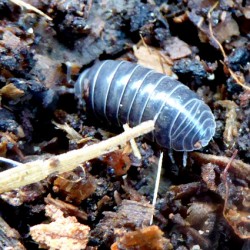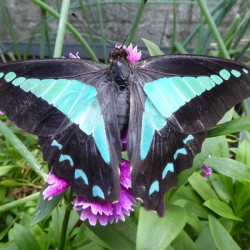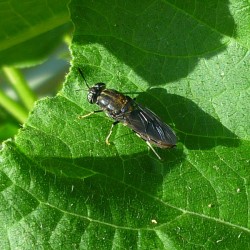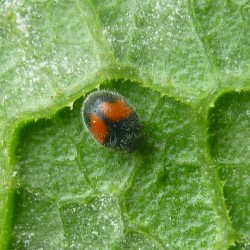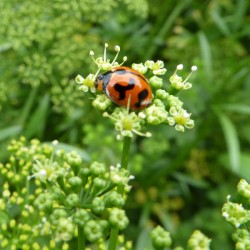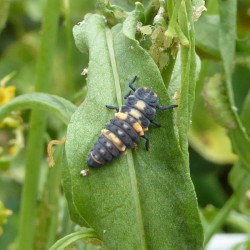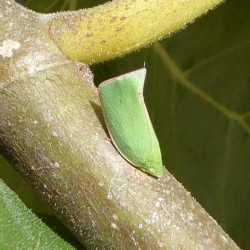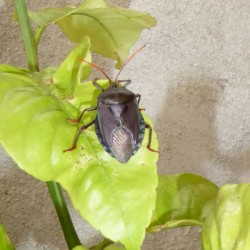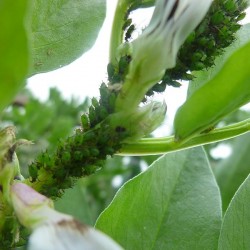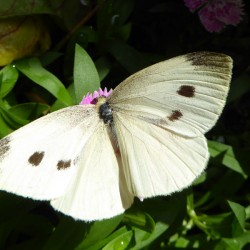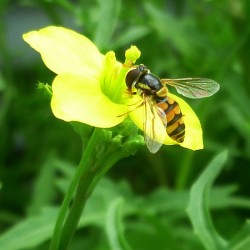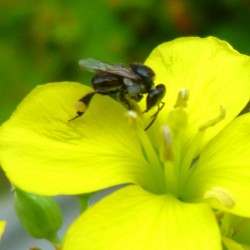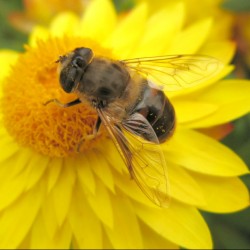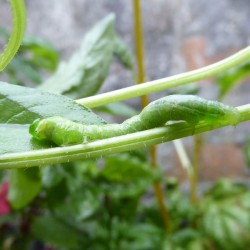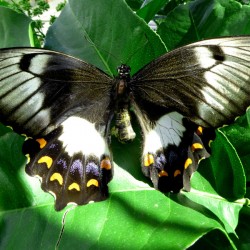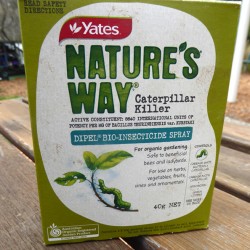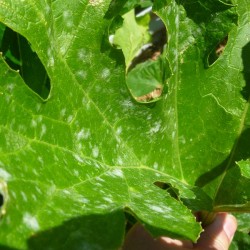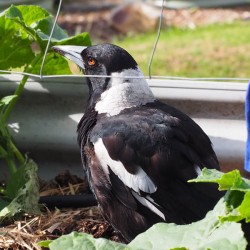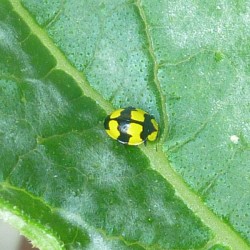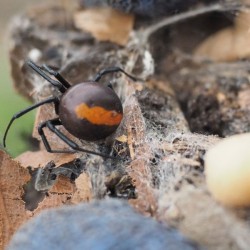Animals in our garden
Blue triangle
Blue triangles, also called common bluebottles, are swallowtail butterflies native to eastern Australia and southeastern Asia. They are very quick and skillful fliers and reach a wingspan of 8 cm. The butterfly itself feeds on nectar, its caterpillar specialises on the leaves of Australian native trees and doesn’t affect any of the crops in our garden. [more]
Black soldier fly
Black soldier flies are slender flies about 18 mm long and 5 wide with a dark black body and transparent wings, usually folded together on their backs. The flies are fairly slow moving, often not even trying to escape. They mimic the appearance of wasps to scare off predators but can’t sting or bite. The [more]
Minute two-spotted ladybird
This shy little beetle is just 3 mm big and a native to eastern and southern Australia. It will drop or fly away quickly if disturbed. If we think of beetles the picture of a ladybird is very often the first thing that comes into our mind. The minute two-spotted ladybird doesn’t really match this [more]
Transverse ladybird
If we think of beetles the picture of a ladybird is very often the first thing that comes into our mind. The funny little red or orange beetles with black dots are frequent visitors to our gardens and usually people don’t mind them and find them rather cute. Some people find they bring luck. Some [more]
Ladybird larva
Just shy of 1 cm long and a couple of millimeters wide this little hunter certainly looks like a little alien. Don’t worry, it doesn’t do any harm to humans, neither does it harm any plant. It does mean business though when it comes to its favorite food: aphids, scale insects and mealybugs. Ladybird larvae [more]
Green plant hopper
About 15 mm small and shaped like a bright green triangle green plant hoppers are very well disguised as a leaf. Most often you will only realise they are around when they hop long distances to escape after being disturbed. A member of the bug family they are a pest sucking on the plant’s sap. [more]
Dealing with citrus stink bugs
When inspecting plants look out for tell-tale signs: the actual animals, often sucking at the most tender leaves. Black adult or orange immature bugs limp and wilting leaves leaves that show brown, burnt areas intense, repugnant citrus smell Preventive measures: Not many predators go for stink bugs because of their caustic defence tactics. Make sure [more]
Dealing with aphids
When inspecting plants look out for tell-tale signs: the actual animals, often sucking at the most tender leaves plenty of ants patrolling the plants limp and wilting leaves sugary, sticky honeydew on the leaves Preventive measures: Aphids are hard to prevent, but there are a lot of predators eating aphids. Companion plant flowers with the [more]
Cabbage butterfly
This 5 cm large butterfly is a common sight in the garden. It has white wings with black tips and dots. There are several species of cabbage butterfly that look and behave very similar. Other names of those butterflies are large white butterfly or small white or simply white butterfly depending on the species. The [more]
Aphids
Aphids are soft skinned sap-sucking insects. They are tiny animals about 2 to 8 mm long. Aphids come in a range of colours: green, black and brown, whitish and light red. Other names are black-fly and green-fly. Most aphids species specialise on particular host plants. They are a serious and if not contained devastating pest. [more]
Hover-fly
Hover-flies look like little wasps. They have a yellow and brown striped back and transparent wings. This mimicry helps them to scare off predators. Despite their looks hover-flies are harmless to humans, they are a real fly. The feature that lends them the name is their peculiar flight behavior. They hover in the air at [more]
Native bee
Native bees are important pollinators in our garden. While foraging for nectar and pollen they also distribute pollen from one flower to another. By doing this they make sure that our plants get fertilised and can set fruit. To attract native bees to our garden we offer them a variety of flowering plants, that we [more]
Honey bee
Honey bees are important pollinators in our garden. While foraging for nectar and pollen they also distribute pollen from one flower to another. By doing this they make sure that our plants get fertilised and can set fruit. To attract honey bees to our garden we offer them a variety of flowering plants, that we [more]
Dealing with caterpillars
Caterpillars are the larvae of butterflies and moths. They are voracious eaters can can easily destroy a crop. The two most common caterpillars we deal with in our garden are the cabbage butterfly larvae and the larvae of the tomato bud worm. Preventive measures to avoid caterpillar problems Plant companion plants! This confuses the parent [more]
Orchard swallowtail
Who says that pests have to be ugly? The adult stage of this animal is a beautiful butterfly. Indigenous to eastern Australia and PNG these butterflies have a wingspan of up to 14 cm. They are mostly black and white with red, orange and blue patterns on their back wings. The larvae is a [more]
Budworm moth
Budworms are caterpillars of the Helicoverpa moth family. The moths lay their eggs at night on young foliage close to fruits or flower buds and the young caterpillars feed on the foliage first before moving into buds or developing fruits. Budworm moths choose several fruits for their young ones, in our garden they are a [more]
Dipel
Dipel is a product used to control caterpillars. It is approved for use in organic gardening. It is made from naturally occurring bacteria (Bacillus thuringiensis) and is safe on bees, ladybirds, birds, fish, mammals and pets. Dipel has no withholding period: vegies, fruit and salad ingredients can be washed and eaten immediately after spraying. [more]
Powdery mildew
Powdery mildew is the name of a variety of fungi, that affect the leaves of plants. They are present everywhere in the environment and are brought in by wind, birds and insects. Powdery mildew loves warm humid nights and dry, warm and shady areas of the garden. Really wet conditions and constant very high or [more]
Magpie
Members of our resident flock of magpies are a common sight in our garden. Adults and young birds can be seen walking around on the ground inspecting our beds. With their piebald plumage they are easy to identify. One of the most accomplished Australian songbirds they entertain us with their beautiful calls, sometimes even mimicking [more]
Tawny frogmouth
Frogmouths are nocturnal birds. They are often confused with owls but only distantly related. They are native Australian birds and can grow up to 50 cm tall. Frogmouths have an amazing way of disguise. On the day the birds sit on a tree motionless, the head usually held up high: it is hard to distinguish [more]
Fungus eating ladybird
The fungus eating ladybird does as it’s name says: it feeds on fungi. It’s not actually looking for mushrooms – mould and mildew are what the little beetle is after. This native Australian ladybird is about 5 mm long and shows bright yellow dots that look square-ish and somehow frayed. Its larvae is about 10 [more]
Red back spider
Take care when reaching for items in the garden that haven’t been disturbed for a while, look out for animals that may hide there. Shake out gloves before using them but always wear gloves when gardening. Warm dry places are very attractive to red back spiders. Their favourite prey, insects and slaters, is available in abundance [more]
